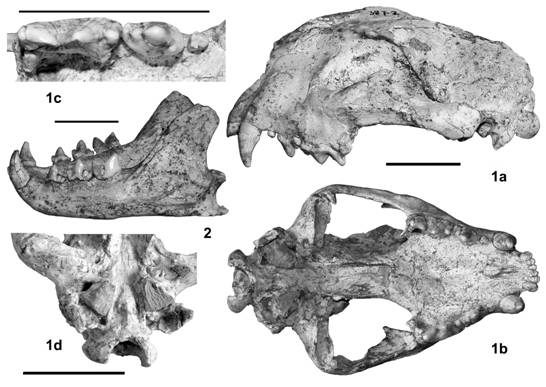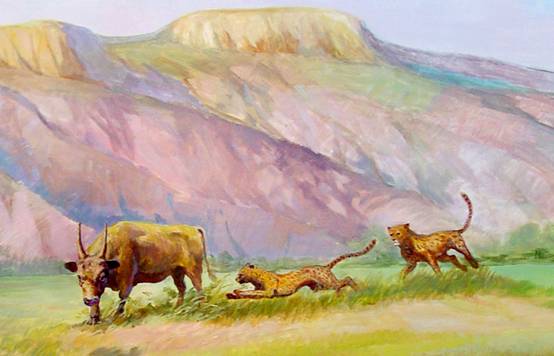
In a 24 December 2010 News Focus story in Science, Dr. DENG Tao, Institute of Vertebrate Paleontology and Paleoanthropology, Chinese Academy of Sciences (IVPP), presented a query for a 2009 PNAS paper by Per Christiansen of the Zoological Museum in Copenhagen and Ji H. Mazák of the Shanghai Science and Technology Museum. Christiansen and Mazák reported a new species of the cheetah (Acinonyx kurteni) from the Late Pliocene loess deposits of the Linxia Basin in Gansu Province, China. As a vertebrate paleontologist who specialized on the Late Cenozoic mammals of the Linxia Basin for many years, DENG naturally had particular interests in reading this paper. Having carefully checked the described skull in this paper’s figures, unfortunately, he found that Christiansen and Mazák studied a fossil forgery, the sole foundation of the paper. In a March 4, 2011 letter in Science, Mazák and Christiansen note “the occipital area and zygomatic arches have been heavily restored in plaster, probably to make it appear more complete, thus enhancing its commercial value, a common malpractice among Chinese fossil dealers.” DENG and his colleague responded, also in Science, that they are pleased to see this note, but stand by their view that the skull is a composite with fabricated features.
In the beginning of 2009 in National Geographic News, DENG pointed out the problems in this PNAS paper. DENG was “astonished” to read the new study. The newly identified skull is not from a new species, he said. DENG explained his team had already described this species as Sivapanthera linxiaensis. DENG said Sivapanthera is the fossil genus of the ancient cheetah. Today’s cheetahs belong to the Acinonyx genus. As Christiansen and Mazák admitted, teeth are highly diagnostic for identification of the cheetah in general, and for the establishment of their new species in particular. A straightforward comparison shows that the morphology and measurements of the cheek teeth of the new skull fall within the variation ranges of S. linxiaensis. Revealingly, Christiansen and Mazák cited the monograph of QIU and his colleagues as the basis of their geologic age determination, but did not mention anywhere in their paper about the previously established species, not to mention any direct comparison of the two forms. DENG also said that the skull in the new study was not an intact original, but rather a compilation from bones of various individuals and possibly even various species. The difference between an intact skull and a compilation is apparent from comparisons of the photos of the skull in the current study and the skulls his team studied, DENG said. In order to confirm these observations, DENG requested an examination to the skull in person, but Mazák declined to grant him access to the specimen.
Despite being unable to examine the new specimen, DENG said, the forged parts of this skull are easily recognized from the figures of their paper. In lateral view of the skull, it clearly shows that the zygomatic arch is not only unnaturally high and robust, without postorbital process, which is usually prominent and pointed in the cheetah, but also has clear boundaries where the “zygomatic” was artificially pieced together with the skull. Furthermore, the zygomatic arch does not belong to the skull, and it may not be a zygomatic arch of a carnivore at all. The occipital part is obviously not original, and it is undoubtedly artificial for several reasons. The direction of the occipital surface is so abnormal that it becomes almost horizontally oriented and its lowest point connects directly with the posterior end of the zygomatic arch. In so doing, there is no space left at all for the tympanic bullae, the mastoid and paroccipital processes, and the occipital condyles. In dorsal view of the skull, the parietal area was glued together with some bone pieces to imitate the skull of a modern cheetah, but the forger did not make the parietal crests, and in doing so giving away the nature of the forgery. The braincase, with a sagittal crest, was made of plaster and painted also to imitate the skull of the modern cheetah. Some large rounded plaster spots and unpainted areas on the parietal and occipital parts are very marked, which indicate that the braincase is a plaster cast. Many traces of daubing plaster can be easily observed in the posterior part of the skull. In ventral view of the skull, the whole basioccipital area is filled and daubed with plaster; because this area is so complicated that the forger could not replicate the morphology seen in the modern cheetah. As a result, no anatomical structures can be found in this area.
Frequent contacts with the local “dragon-bone” dealers during DENG’s work in the Linxia area gave him knowledge that it is quite common to come across such forgery, especially in recent years. Personally, DENG has seen hundreds of seemingly “complete” skulls of various kinds, and he knows well that unqualified collectors are often cheated by being sold forgeries. Unfortunately, Mazák was one of them.
Christiansen and Mazák alleged that the skull specimen was from the ‘‘Hezheng’’ locality, with an estimated age of ~2.2-2.5 million years. In fact, Hezheng is not a locality, but a county of Linxia Prefecture, where no fossil mammals have ever been found from loess deposits so far as DENG knows. A “fossiliferous-rich locality” does exist, but it is Longdan in Dongxiang County of Linxia Prefecture. A monograph on the Longdan fauna was already published by QIU and his colleagues in 2004, wherein the new cheetah species, Sivapanthera linxiaensis, was described, based on two skulls with their articulated lower jaws and other isolated skull or lower jaw specimens. Without further details to be gleamed from personal examination of the specimen in question, DENG can only conclude that, at a minimum, Christiansen and Mazák completely failed to do due diligence to establish a new species at multiple levels: failing to recognize a fake specimen; failing to work on an actual specimen, because the senior author, Christiansen, relied on photos to describe a new species, as Mazák said; failing to explore and verify a fossil locality; failing to inspect primary literature; and failing to acknowledge an existing taxon.
To sum up, the conclusion of Christiansen and Mazák is based on a fossil forgery, so it is extremely unfounded and groundless. DENG wrote to PNAS on 16 January 2009 and strongly urged the authors or the journal to retract this paper. In a 4 February 2009 letter to DENG, PNAS stated that his observations do not suggest “he examined the skull in person”. DENG said he has not pursued the matter further because Mazák has declined to give him access to the skull.
Now Mazák and Christiansen argue that DENG’s inquiries “were presented without tangible evidence” and “they were based not on personal study of the specimen but on a few images in our study”. But as mentioned above, DENG had asked for an opportunity to examine the skull in person, only to have Mazák decline his request. Adding to this irony, according to Mazák, Christiansen, the senior author, had composed the paper without having seen the original specimen, and only based his descriptions on photos of the specimen. Unfortunately, Mazák and Christiansen insist that this altered skull does not impinge on Acinonyx kurteni’s status as a primitive cheetah. DENG indicates that the occipital area and zygomatic arches have not only been described in their original paper, but also in their phylogenetic and principal components analyses. DENG also emphasizes that the authors committed grave errors, which did serious harm to the field of vertebrate paleontology and damaged the credibility of PNAS.
 |
|
Fig.1: Fabricated features in Holotype of A. kurteni, n.sp. SHNM8.1.07 (Shanghai Science and Technology Museum; People's Republic of China) in lateral (A); dorsal (B);and ventral (c) views.(Marked by DENG Tao from PNAS) |
 |
|
Fig.2: Skull and lower jaw of the cheetah Sivapanthera linxiaensis (Scale bars = 5 cm) (Image by DENG Tao) |
 |
|
Fig.3: Two cheetahs of Sivapanthera linxiaensis are hunting a bovid of Leptobos brevicornis (Illustrated by Li Rongshan) |

86-10-68597521 (day)
86-10-68597289 (night)

52 Sanlihe Rd., Xicheng District,
Beijing, China (100864)

